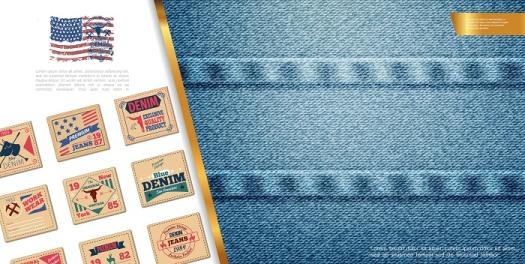Embroidered patches have a fascinating history that goes back hundreds of years. That was its original purpose: to show rank and affiliation in the military. Its use has since greatly expanded.
Nowadays, embroidered decorative patches are a unique way to show who you are and what you stand for. Style and individuality can be seen in everything from denim jackets to backpacks.
This small but useful item has gone from being useful in a specific situation to being widely popular. Explore with us the history of the embroidered patch and learn about its fascinating cultural journey. Continue reading.

Table of Contents
The Origins of Military Use
From ancient times, when they were used by the military, the idea of embroidered patches can be traced back. Rank and unit patches were worn on soldiers’ uniforms to show who they were.
As an example of how important craftsmanship is, these early patches were made by hand embroidery. It became more common in the armed forces to wear patches as the years went by.
World War II and Standardization
Patches were very important for identification and morale during World War II. The military started to make these patches in the same way every time they were made. They were used to show rank and loyalty, and they also helped soldiers get to know each other better.
During this time, more and more embroidered patches were made by machines, which made them easier to find and more uniform. Military fans loved the patches so much that they started collecting them.
Post-War Popularity
When veterans came home from the war, they brought their patches with them. This was the first step in their return to normal life. These items were a badge of honor and a reminder of the service they had given.
As the patches became more popular, people started putting them on jackets and other everyday clothes. This was the start of their change from military symbols to fashion accessories.
The Rise of Subcultures
During the 1960s and 1970s, a lot of different youth subcultures formed, and embroidered patches were a big part of these. As a way to show who they were, hippies, bikers, and rock bands all used patches.
A lot of the time, these patches were personalized with words, pictures, and symbols that showed what each group stood for and who they were. This period made the patch even more of a symbol of individuality and rebellion.
The Punk Revolution
There was a big change in the use of embroidered patches during the punk movement in the late 1970s and early 1980s. Punk bands and their fans wore patches to show that they were against the establishment and to make political statements.
Often, these patches had big graphics and messages that were thought to be offensive. They were worn on leather jackets a lot, which made a tough-looking subculture. During the punk revolution, patches became strong signs of identity and defiance.
The Mainstream Fashion Industry
In the 1980s and 1990s, patch fashion started to get attention from big-name fashion designers. When high-end brands started adding patches to their collections, they turned them into trendy elements that could be worn every day.
Because patches were so flexible, they could be easily added to a wide range of styles, from casual streetwear to high-class couture. Patches crossed over from the subculture to the mainstream during this time.
The Influence of Pop Culture
The popularity of embroidered patches grew in new areas thanks to pop culture. Television shows, movies, and music stars all used patches on their clothes and other items. Because of this, patches became more popular and became an important part of fashion.
Patches were used by famous people like Michael Jackson and Madonna to make their looks stand out. Because of this, patches became a symbol of modern fashion trends and pop culture.
DIY and Customization Boom
For the most part, embroidered patches are at the forefront of the DIY culture that has come back to life in the 21st century. As a way to personalize and style their clothes, patches have become very popular.
Due to online stores and lower production costs, making custom patches has become very easy for many people. Everyone now has a bigger say in how patches are made, which makes each patch special and unique.
The Global Market
The demand for embroidered patches has grown around the world, showing that people like them a lot. You can find patches on clothes, uniforms, and accessories all over the world, from Asia to Europe to the Americas.
International sales have become easier thanks to the Internet, which lets customers see designs from all over the world. This ability to reach people all over the world has also led to new ideas, and patch styles are now influenced by many different cultures. Because of this, the embroidered patch business is stronger and more connected than ever.
Environmental Considerations
Making embroidered patches has effects on the environment that can’t be ignored. Chemicals that are bad for the environment can get into water sources during traditional dyeing methods. But now, a lot of companies are switching to materials that are better for the environment and last longer.
Using organic fabrics and recycling old patches are two ways to help the environment. Digital crafting technology also cuts down on waste by precisely cutting the materials needed for each patch.
Cultural Symbolism
Embroidered patches often hold deep cultural meaning and show who you are, what you believe, and where you belong. These patches tell stories or remember important events in many cultures.
Patches are a way for indigenous groups, bikers, and sports teams to show unity and heritage. People who collect patches see them as pieces of history from certain times or events.
Because of this strong cultural link, simple fabric patches become strong symbols of identity and tradition. The patches offer a fascinating glimpse into societal evolution and human expression.
Embroidered Patch as a Canvas for Artistic Expression
The embroidered patch has changed a lot over the years. It went from being a military insignia to a trendy accessory, and it gained a lot of cultural meaning along the way.
Every patch has a story to tell, whether it’s about service, rebellion, or just personal style. It still has a lot of fans in both subcultures and mainstream fashion.
In a small but powerful way, the embroidered patch shows off a person’s identity. This timeless symbol still speaks to people of all ages and backgrounds.
Did you like this guide? Great! Please browse our website for more!




